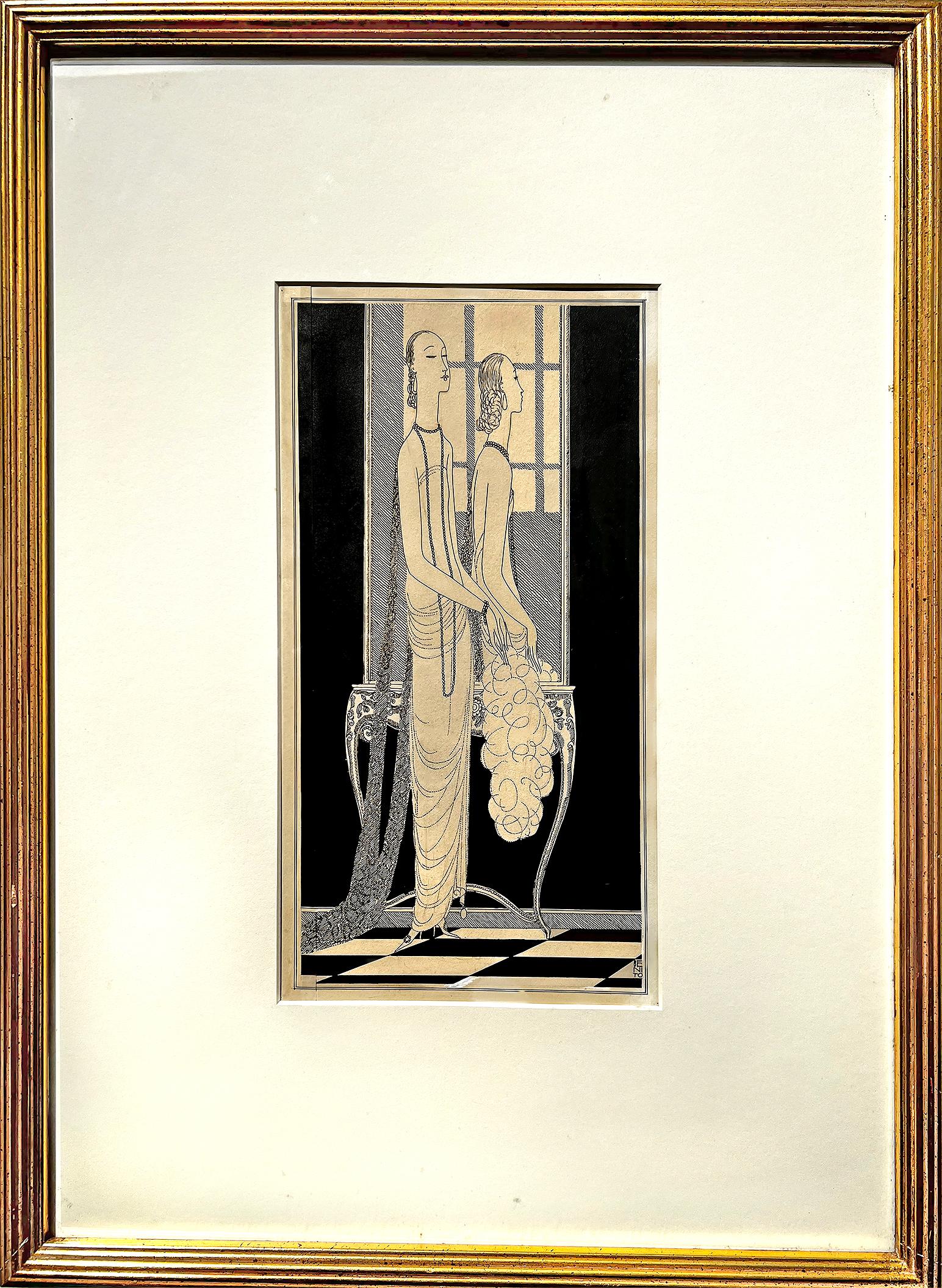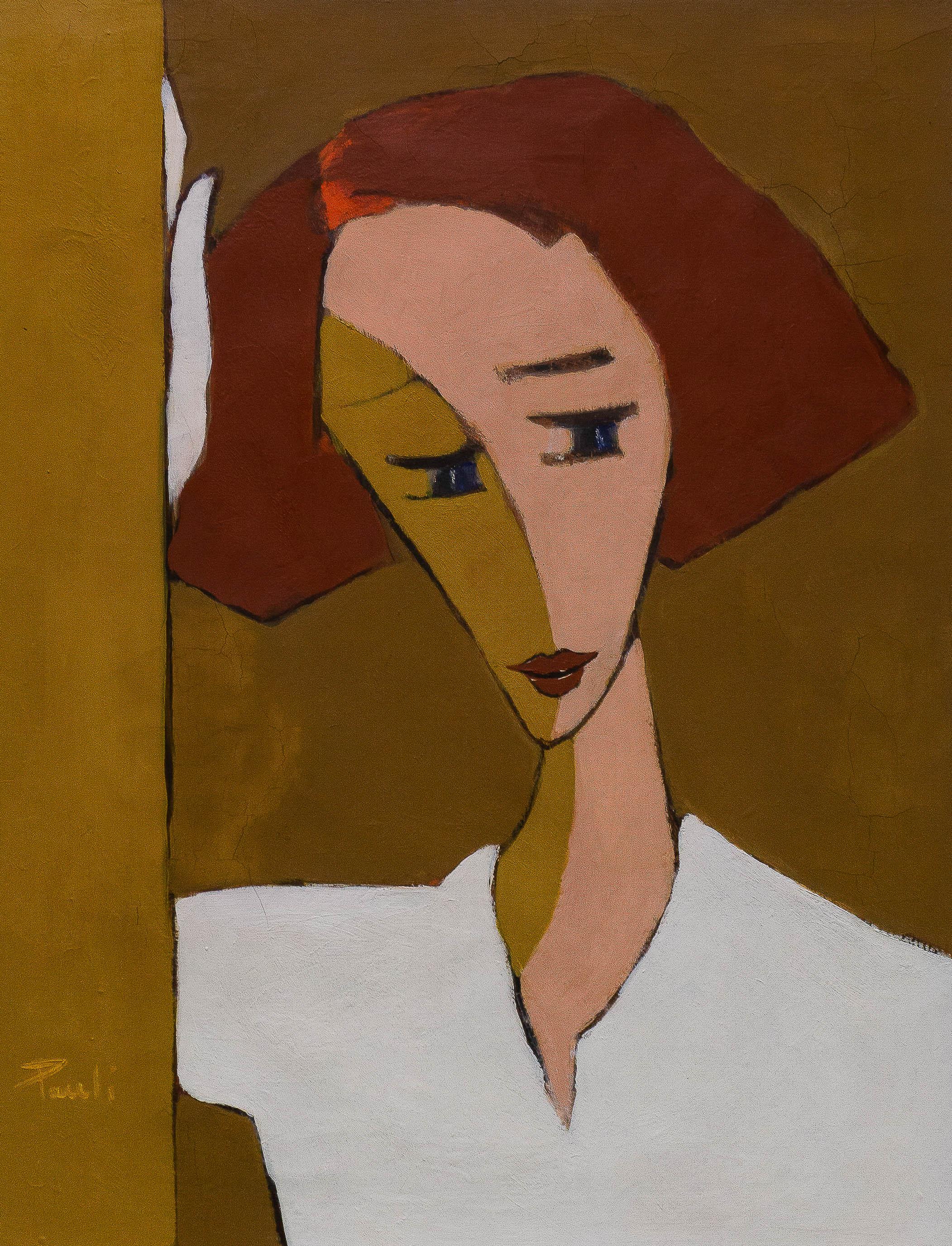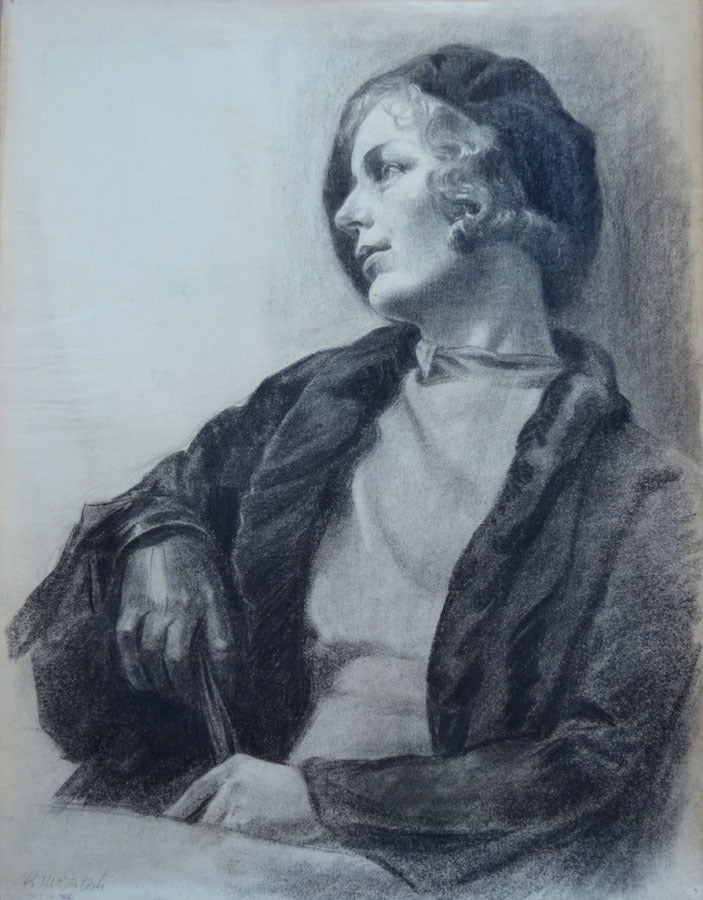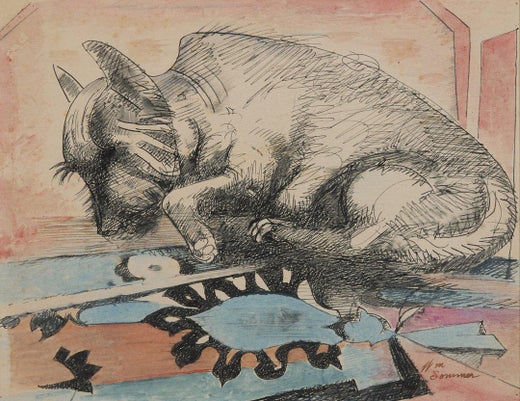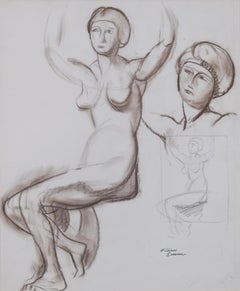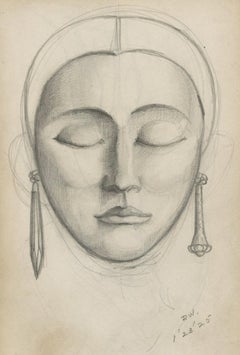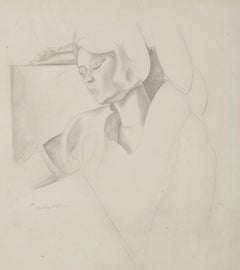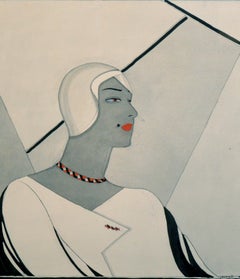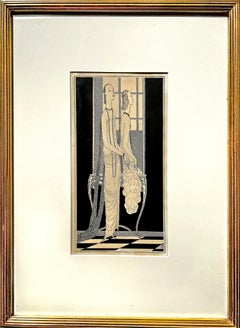Want more images or videos?
Request additional images or videos from the seller
1 of 9
William SommerDeco Womanc. 1918-20
c. 1918-20
$1,800
£1,366.53
€1,563.02
CA$2,514.86
A$2,797.07
CHF 1,460.55
MX$34,037.42
NOK 18,653.39
SEK 17,493.59
DKK 11,665.40
Shipping
Retrieving quote...The 1stDibs Promise:
Authenticity Guarantee,
Money-Back Guarantee,
24-Hour Cancellation
About the Item
Deco Woman
Crayon on paper, c. 1920
Signed in ink lower left: "Wm. Sommer" (see photo)
Provenance:
Estate of the artist
Edwin Sommer (the artist’s son)
Joseph Erdelac, Cleveland (JME inventory # verso)
Connie Erdelac (daughter)
Note: This drawing was executed in the early 1920s while Sommer was active in the Kokoon Klub.
Condition: Excellent
Image size: 15 1/4 x 11 inches
Frame: 25 1/8 x 21 1/8 inches
William Sommer
(1867-1949)
William Sommer is seen as a key person in bringing European modernism to Northeast Ohio. He was born in Detroit, Michigan, and in his youth apprenticed for seven years to a lithographer.
He briefly studied at an art academy in Germany and then worked as a lithographer in New York before moving to Cleveland, where he was awarded a major contract with the Otis Lithography Company. There he became friends with sculptor and painter William Zorach, and the two, determined to be fine artists, began painting together on weekends. They also became intrigued by avant-garde movements, especially after Zorach's trip to Paris in 1910.
In 1911, Sommer co-founded a group in Cleveland called the Kokoon Club, a mixed group of commercial artists and radical modernists who sought the freedom to pursue their independent tendencies. They converted a tailor's shop into a studio and held exhibitions and lectures and organized an annual masked ball that became the focus of Cleveland's bohemian life.
In 1913, he and his colleagues began painting at Brandywine, about 30 miles south of Cleveland and made a school house into a studio. They devoted increasing time to watercolor painting because they could work spontaneously and it would dry quickly. Rejecting the conventional ideas of beauty, they strove for the expression of emotion and spontaneity and fantasy. One of Sommer's most successful students was Charles Burchfield.
As he was perfecting his mature style, he had financial difficulties because he made his living from commercial lithography, which was becoming obsolete, and the Depression was hitting the nation causing him to lose his job. He became a WPA artist, doing murals in northeastern Ohio.
After his death at age 82, he was largely forgotten until 1980 when Hilton Kramer, a "New York Times" critic, praised his work. In May to July, 1994, the Ohio Arts Council held a retrospective of his work at the Riffe Gallery in Columbus. His work is found in many public collections including the National Museum of American Art, The Metropolitan Museum of Art, and the Whitney Museum of American Art.
Courtesy, AskArt
- Creator:William Sommer (1867-1949, American)
- Creation Year:c. 1918-20
- Dimensions:Height: 15.25 in (38.74 cm)Width: 11 in (27.94 cm)
- Medium:
- Movement & Style:
- Period:
- Condition:Original.
- Gallery Location:Fairlawn, OH
- Reference Number:Seller: FA89131stDibs: LU14011686352
William Sommer
William Sommer is seen as a key person in bringing European modernism to Northeast Ohio. He was born in Detroit, Michigan, and in his youth apprenticed for seven years to a lithographer. He briefly studied at an art academy in Germany and then worked as a lithographer in New York before moving to Cleveland, where he was awarded a major contract with the Otis Lithography Company. There he became friends with sculptor and painter William Zorach, and the two, determined to be fine artists, began painting together on weekends. They also became intrigued by avant-garde movements, especially after Zorach's trip to Paris in 1910. In 1911, Sommer co-founded a group in Cleveland called the Kokoon Club, a mixed group of commercial artists and radical modernists who sought the freedom to pursue their independent tendencies. They converted a tailor's shop into a studio and held exhibitions and lectures and organized an annual masked ball that became the focus of Cleveland's bohemian life. In 1913, he and his colleagues began painting at Brandywine, about 30 miles south of Cleveland and made a school house into a studio. They devoted increasing time to watercolor painting because they could work spontaneously and it would dry quickly. Rejecting the conventional ideas of beauty, they strove for the expression of emotion and spontaneity and fantasy. One of Sommer's most successful students was Charles Burchfield. As he was perfecting his mature style, he had financial difficulties because he made his living from commercial lithography, which was becoming obsolete, and the Depression was hitting the nation causing him to lose his job. He became a WPA artist, doing murals in northeastern Ohio. After his death at age 82, he was largely forgotten until 1980 when Hilton Kramer, a "New York Times" critic, praised his work. In May to July, 1994, the Ohio Arts Council held a retrospective of his work at the Riffe Gallery in Columbus. His work is found in many public collections including the National Museum of American Art, The Metropolitan Museum of Art, and the Whitney Museum of American Art.
About the Seller
5.0
Recognized Seller
These prestigious sellers are industry leaders and represent the highest echelon for item quality and design.
Gold Seller
Premium sellers maintaining a 4.3+ rating and 24-hour response times
Established in 1978
1stDibs seller since 2013
799 sales on 1stDibs
Typical response time: <1 hour
Associations
International Fine Print Dealers Association
- ShippingRetrieving quote...Shipping from: Fairlawn , OH
- Return Policy
Authenticity Guarantee
In the unlikely event there’s an issue with an item’s authenticity, contact us within 1 year for a full refund. DetailsMoney-Back Guarantee
If your item is not as described, is damaged in transit, or does not arrive, contact us within 7 days for a full refund. Details24-Hour Cancellation
You have a 24-hour grace period in which to reconsider your purchase, with no questions asked.Vetted Professional Sellers
Our world-class sellers must adhere to strict standards for service and quality, maintaining the integrity of our listings.Price-Match Guarantee
If you find that a seller listed the same item for a lower price elsewhere, we’ll match it.Trusted Global Delivery
Our best-in-class carrier network provides specialized shipping options worldwide, including custom delivery.More From This Seller
View AllFemale Nude Study
By William Sommer
Located in Fairlawn, OH
Female Nude Study
Graphite and crayon on wove paper, c. 1928
Signed with the Estate stamp "B" (see photo)
Provenance: Estate of the Artist
Edward Sommer (his so...
Category
1920s American Modern Nude Drawings and Watercolors
Materials
Crayon
Head of a Deco Woman (recto) Standing Male Model (verso)
By Paul H. Winchell
Located in Fairlawn, OH
Head of a Deco Woman (recto) Standing Male Model (verso)
Graphite on paper, 1925
Signed with the artist's initials "PW" and dated 1925
Created while the artist was studying at the ...
Category
1920s Art Deco Figurative Drawings and Watercolors
Materials
Graphite
Head of a Deco Woman (recto) Standing Male Model (verso)
By Paul H. Winchell
Located in Fairlawn, OH
Head of a Deco Woman (recto) Standing Male Model (verso)
Graphite on paper, 1925
Signed with the artist's initials "PW" and dated 1925
Created while the artist was studying at the Art Institute of Chicago in 1925.
This is a preliminary drawing to a series of class assignments.
From a sketch book
Image/Sheet size: 7 5/8 x 4 7/8 inches
Condition: Excellent Slight syrface dirt
Provenance: Estate of the Artist
Winchell Heirs
Paul H. Winchell (1903 – 1971) was a printmaker, illustrator, teacher, and gilder according to Crump, 2009 (Minnesota Prints and Printmakers, 1900- 1945, Minnesota Historical Society Press). He was the son of Mrs. Looman Winchell of Shepherd Rd as noted in a 1937 newspaper article (Painsville, O. Telegraph). Winchell grew up in North Perry, Ohio and then studied and worked as an instructor at the Art Institute of Chicago. He studied with Leon Kroll (1884 – 1974), Boris...
Category
1920s Art Deco Figurative Drawings and Watercolors
Materials
Graphite
Portrait of Gladys Anne Hoskyns
Located in Fairlawn, OH
Portrait of Gladys Anne Hoskyns
Collotype after a Wyndham Lewis drawing, 1923
Singed in the plate and reinforced in pencil
Published by The Dial Publishing Company in Living Art...
Category
1920s Modern Figurative Prints
Materials
Lithograph
Standing Female Nude
By William Sommer
Located in Fairlawn, OH
Standing Female Nude
Match stick and ink drawing, c. 1925
Signed with the estate stamp B
Sheet size: 21 x 16 inches
Created at the Kakoon Arts Klu...
Category
1920s American Modern Nude Drawings and Watercolors
Materials
Ink
Woman's Head
By Elie Nadelman
Located in Fairlawn, OH
Edition of 50 printed by Charles White in 1951 for the estate
Bibliography:
Lincoln Kirstein, Elie Nademan (New York: The Eakins Press, 1973),, 20
Elie Nadelman
Born 1882, Warsaw...
Category
1920s American Modern Prints and Multiples
Materials
Drypoint
You May Also Like
Deco Femme
By Thelma Terrell
Located in West Hollywood, CA
Our Gallery acquired the estate of a Northern California artist, Thelma Terrell. Terrell lived in Oakland and was an illustrator and profes...
Category
1930s Art Deco Figurative Paintings
Materials
Mixed Media, Paper
Art Deco Woman before a Mirror - Vogue Magazine Artist
Located in Miami, FL
Fabled Vogue Magazine Cover Artist Eduardo Garcia Benito depicts a perfectly posed long-neck flapper with her reflection in a mirror, Her extrav...
Category
1920s Art Deco Figurative Drawings and Watercolors
Materials
Paper, Ink
Portrait
By Jean-Emile Laboureur
Located in New York, NY
Jean-Emile Laboureur (1877-1943), Portrait, 1917, engraving, signed in pencil lower left and numbered lower right (28/40). Reference: S. Laboureur 170, third state (of 3), from the e...
Category
1910s Art Deco Portrait Prints
Materials
Engraving
Art Deco Woman before a Mirror - Vogue Magazine Artist
Located in Miami, FL
Fabled Vogue Magazine Cover Artist Eduardo Garcia Benito depicts a perfectly posed long-neck flapper with her reflection in a mirror, Her extrav...
Category
1920s Figurative Drawings and Watercolors
Materials
Paper, Ink, Gouache
The artist
By Gilbert Pauli
Located in Geneva, CH
Born in 1944 in the canton of Fribourg, Gilbert Pauli currently lives in Geneva, where he devotes himself to painting and sculpture, a passion he developed from his childhood. His fa...
Category
1990s Art Deco Portrait Paintings
Materials
Oil, Canvas
$960 Sale Price
61% Off
Mademoiselle
By Robert McIntosh
Located in West Hollywood, CA
A rare, early original figurative charcoal by American artist Robert McIntosh(1916-2010)
Robert McIntosh was extremely prolific and exhibited throughout his lifetime, including fi...
Category
1930s Art Deco Figurative Drawings and Watercolors
Materials
Charcoal, Paper
Price Upon Request
More Ways To Browse
Art Deco Woman
Art Deco Key
William Majors
Paris Art Deco Paintings
American Art Deco Painting
Art Deco Painting 1920s
Painting Woman 1920s
Art Deco Murals
Wpa Art Charles
Art Deco Detroit
Antique Watercolor Painting
Antique Watercolor Paintings
Antique Watercolour Paintings Paintings
French Watercolour Painting
Watercolour Paintings France
White Watercolor Painting
Watercolor Of Italy
Watercolor Paintings City

